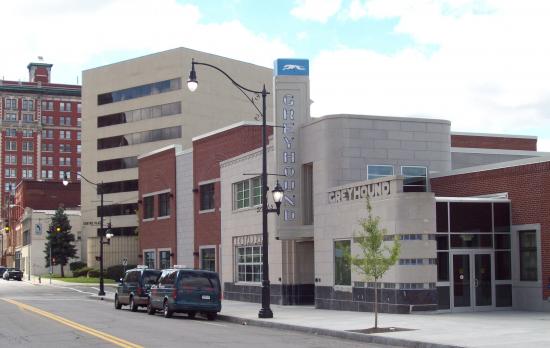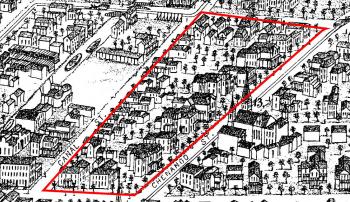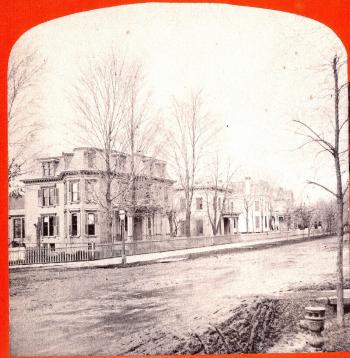
You are standing at the site of Broome County's new bus terminal, which was built in 2010. The new terminal incorporates the facade of the Greyhound bus terminal that previously stood on this site. The Greyhound terminal was built in the 1940s in the Art Deco architectural style and was part of Greyhound's "Streamline Era" terminal program. Binghamton is one of the few areas to retain some architectural connection to the "Streamline Era" terminals, many of which have been demolished. This block has additional historical significance for the City of Binghamton as a 19th century residential area.

The 1873 Bird’s Eye View depicts this block when it was primarily a residential area. You can notice a difference in the size and architectural elaboration of houses between the Chenango Street and the Prospect Street (then Canal Street) sides of the block. Chenango Street was an important entryway to the city, particularly since it connected the railroad station at the corner of Lewis and Chenango Street, where many people arrived in the city, to the main thoroughfare of Chenango Street. The houses fronting on Chenango Street were owned by some of the city’s elite, including successful merchants and building contractors, and illustrate an important 19th century housing trend. Elite families choose to locate their residences within the core of the city on prominent entryways and blocks as a highly visible display of their wealth. This contrasts with contemporary preferences of the wealthy and middle-class to live outside of urban areas.

This is a late 19th century stereographic image of the Chenango Street side of the block, which looks north from the Henry Street end of the block. The large homes of the elite which are shown in this photo began to be replaced by the turn of the 20th century with commercial structures and factories. The George Kent cigar factory replaced the third house from the corner and was part of the boom in cigar production in Binghamton. Binghamton was second only to New York City in cigar production during this period and many immigrants came to the city to work in this industry. The second house from the corner became the site of the Greyhound Bus Station in the 1940s.
Archaeologists excavated part of this block prior to the construction of the new bus terminal and identified portions of house foundations, wells, cisterns, and a privy (outhouse). The privy shown on the right in this photo was located behind one of the more modest houses on Prospect Avenue (formerly Canal Street). The house was occupied by a middle-class family, who are responsible for the deposits in the privy, including the trash we found, such as broken dishes, bottles, and animal bones. In the 19th century, trash service was not available and people could dispose of it by scattering it in their yards, piling it in discrete dumps on their properties, digging pits to place it in, or throwing it down deep shaft features, such as privies or wells. This was usually done when these features were no longer in use. But our research indicated that the family connected to this privy threw their daily trash in here while they were actively using it. Most other trash disposal options required either leaving trash exposed in the yard or having an open trash pit, both of which were unattractive and could be messy. This family was willing to use up valuable privy space to keep trash out of their yard and present their property as neat and tidy. Cleanliness, and its lack, were often linked to morality and financial success in the 19th century. Families with clean properties were more likely to be seen as moral, ambitious, and deserving of wealth and success.